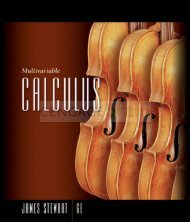Understanding Statistics in the Behavioral Sciences ... - NelsonBrain
Understanding Statistics in the Behavioral Sciences ... - NelsonBrain
Understanding Statistics in the Behavioral Sciences ... - NelsonBrain
You also want an ePaper? Increase the reach of your titles
YUMPU automatically turns print PDFs into web optimized ePapers that Google loves.
Licensed to:<br />
18 C H A P T E R 1 <strong>Statistics</strong> and Scientifi c Method<br />
■ QUESTIONS AND PROBLEMS<br />
Note to <strong>the</strong> student: You will notice that at <strong>the</strong> end of<br />
specifi c problems <strong>in</strong> this and all o<strong>the</strong>r chapters except<br />
Chapter 2, I have identifi ed, <strong>in</strong> color, a specifi c area with<strong>in</strong><br />
psychology and related fi elds to which <strong>the</strong> problems<br />
apply. For example, Problem 6, part b, is a problem <strong>in</strong> <strong>the</strong><br />
area of biological psychology. It has been labeled “biological”<br />
at <strong>the</strong> end of <strong>the</strong> problem (“psychology” is left off<br />
of each label for brevity). The specifi c areas identifi ed are<br />
cognitive psychology, social psychology, developmental<br />
psychology, biological psychology, cl<strong>in</strong>ical psychology,<br />
<strong>in</strong>dustrial/organizational (I/O) psychology, health psychology,<br />
education, and o<strong>the</strong>r. I hope this label<strong>in</strong>g will be<br />
useful to your <strong>in</strong>structor <strong>in</strong> select<strong>in</strong>g assigned homework<br />
problems and to you <strong>in</strong> see<strong>in</strong>g <strong>the</strong> broad application of<br />
this material as well as <strong>in</strong> help<strong>in</strong>g you select additional<br />
problems you might enjoy solv<strong>in</strong>g beyond <strong>the</strong> assigned<br />
ones.<br />
1. Defi ne each of <strong>the</strong> follow<strong>in</strong>g terms:<br />
Population Dependent variable<br />
Sample Constant<br />
Data Statistic<br />
Variable Parameter<br />
Independent variable<br />
2. What are four methods of acquir<strong>in</strong>g knowledge? Write<br />
a short paragraph describ<strong>in</strong>g <strong>the</strong> essential characteristics<br />
of each.<br />
3. How does <strong>the</strong> scientifi c method differ from each of <strong>the</strong><br />
methods listed here?<br />
a. Method of authority<br />
b. Method of rationalism<br />
c. Method of <strong>in</strong>tuition<br />
4. Write a short paragraph compar<strong>in</strong>g naturalistic observation<br />
and true experiments.<br />
5. Dist<strong>in</strong>guish between descriptive and <strong>in</strong>ferential statistics.<br />
Use examples to illustrate <strong>the</strong> po<strong>in</strong>ts you make.<br />
6. In each of <strong>the</strong> experiments described here, specify (1)<br />
<strong>the</strong> <strong>in</strong>dependent variable, (2) <strong>the</strong> dependent variable,<br />
(3) <strong>the</strong> sample, (4) <strong>the</strong> population, (5) <strong>the</strong> data, and (6)<br />
<strong>the</strong> statistic:<br />
a. A health psychologist is <strong>in</strong>terested <strong>in</strong> whe<strong>the</strong>r fear<br />
motivation is effective <strong>in</strong> reduc<strong>in</strong>g <strong>the</strong> <strong>in</strong>cidence of<br />
smok<strong>in</strong>g. Forty adult smokers are selected from <strong>in</strong>dividuals<br />
resid<strong>in</strong>g <strong>in</strong> <strong>the</strong> city <strong>in</strong> which <strong>the</strong> psychologist<br />
works. Twenty are asked to smoke a cigarette, after<br />
which <strong>the</strong>y see a gruesome fi lm about how smok<strong>in</strong>g<br />
causes cancer. Vivid pictures of <strong>the</strong> diseased lungs<br />
and o<strong>the</strong>r <strong>in</strong>ternal organs of deceased smokers are<br />
shown <strong>in</strong> an effort to <strong>in</strong>still fear of smok<strong>in</strong>g <strong>in</strong> <strong>the</strong>se<br />
subjects. The o<strong>the</strong>r group receives <strong>the</strong> same treatment,<br />
except <strong>the</strong>y see a neutral fi lm that is unrelated<br />
to smok<strong>in</strong>g. For 2 months after show<strong>in</strong>g <strong>the</strong> fi lm,<br />
<strong>the</strong> experimenter keeps records on <strong>the</strong> number of<br />
cigarettes smoked daily by <strong>the</strong> participants. A mean<br />
for each group is <strong>the</strong>n computed, of <strong>the</strong> number of<br />
cigarettes smoked daily s<strong>in</strong>ce see<strong>in</strong>g <strong>the</strong> fi lm, and<br />
<strong>the</strong>se means are compared to determ<strong>in</strong>e whe<strong>the</strong>r <strong>the</strong><br />
fear-<strong>in</strong>duc<strong>in</strong>g fi lm had an effect on smok<strong>in</strong>g. health<br />
b. A physiologist wants to know whe<strong>the</strong>r a particular<br />
region of <strong>the</strong> bra<strong>in</strong> (<strong>the</strong> hypothalamus) is <strong>in</strong>volved<br />
<strong>in</strong> <strong>the</strong> regulation of eat<strong>in</strong>g. An experiment is performed<br />
<strong>in</strong> which 30 rats are selected from <strong>the</strong> university<br />
vivarium and divided <strong>in</strong>to two groups. One<br />
of <strong>the</strong> groups receives lesions <strong>in</strong> <strong>the</strong> hypothalamus,<br />
whereas <strong>the</strong> o<strong>the</strong>r group gets lesions produced <strong>in</strong> a<br />
neutral area. After recovery from <strong>the</strong> operations, all<br />
animals are given free access to food for 2 weeks,<br />
and a record is kept of <strong>the</strong> daily food <strong>in</strong>take of each<br />
animal. At <strong>the</strong> end of <strong>the</strong> 2-week period, <strong>the</strong> mean<br />
daily food <strong>in</strong>take for each group is determ<strong>in</strong>ed.<br />
F<strong>in</strong>ally, <strong>the</strong>se means are compared to see whe<strong>the</strong>r<br />
<strong>the</strong> lesions <strong>in</strong> <strong>the</strong> hypothalamus have affected <strong>the</strong><br />
amount eaten. biological<br />
c. A cl<strong>in</strong>ical psychologist is <strong>in</strong>terested <strong>in</strong> evaluat<strong>in</strong>g<br />
three methods of treat<strong>in</strong>g depression: medication,<br />
cognitive restructur<strong>in</strong>g, and exercise. A fourth treatment<br />
condition, a wait<strong>in</strong>g-only treatment group, is<br />
<strong>in</strong>cluded to provide a basel<strong>in</strong>e control group. Sixty<br />
depressed students are recruited from <strong>the</strong> undergraduate<br />
student body at a large state university,<br />
and fi fteen are assigned to each treatment method.<br />
Treatments are adm<strong>in</strong>istered for 6 months, after<br />
which each student is given a questionnaire designed<br />
to measure <strong>the</strong> degree of depression. The<br />
questionnaire is scaled from 0 to 100, with higher<br />
scores <strong>in</strong>dicat<strong>in</strong>g a higher degree of depression. The<br />
mean depression values are <strong>the</strong>n computed for <strong>the</strong><br />
four treatments and compared to determ<strong>in</strong>e <strong>the</strong> relative<br />
effectiveness of each treatment. cl<strong>in</strong>ical, health<br />
d. A social psychologist is <strong>in</strong>terested <strong>in</strong> determ<strong>in</strong><strong>in</strong>g<br />
whe<strong>the</strong>r <strong>in</strong>dividuals who graduate from high school<br />
but get no fur<strong>the</strong>r education earn more money than<br />
high school dropouts. A national survey is conducted<br />
<strong>in</strong> a large Midwestern city, sampl<strong>in</strong>g 100 <strong>in</strong>dividuals<br />
from each category and ask<strong>in</strong>g each <strong>the</strong>ir<br />
annual salary. The results are tabulated, and mean<br />
salary values are calculated for each group. social<br />
e. A cognitive psychologist is <strong>in</strong>terested <strong>in</strong> how retention<br />
is affected by <strong>the</strong> spac<strong>in</strong>g of practice sessions.<br />
A sample of 30 seventh graders is selected from<br />
a local junior high school and divided <strong>in</strong>to three<br />
Copyright 2011 Cengage Learn<strong>in</strong>g. All Rights Reserved. May not be copied, scanned, or duplicated, <strong>in</strong> whole or <strong>in</strong> part. Due to electronic rights, some third party content may be suppressed from <strong>the</strong> eBook and/or eChapter(s).<br />
Editorial review has deemed that any suppressed content does not materially affect <strong>the</strong> overall learn<strong>in</strong>g experience. Cengage Learn<strong>in</strong>g reserves <strong>the</strong> right to remove additional content at any time if subsequent rights restrictions require it.















